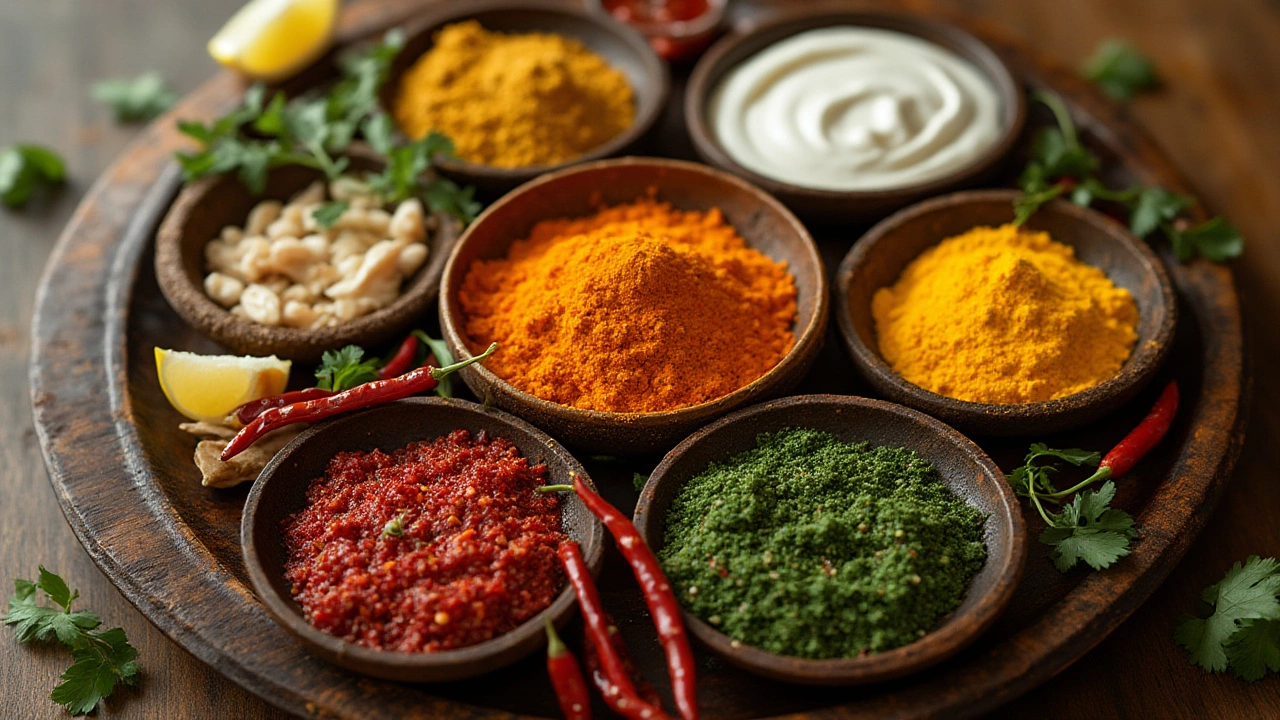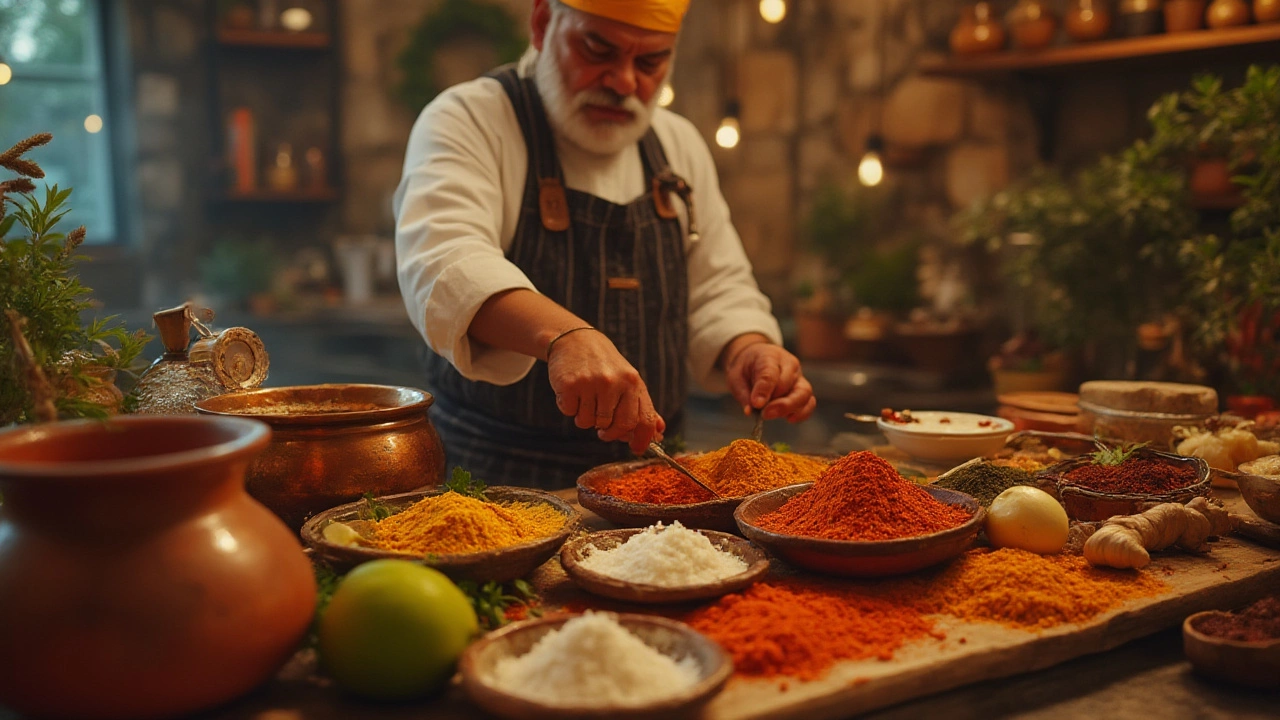It's wild how so many people adore tandoori chicken, but hardly anyone stops to wonder what actually creates that punch of flavor. The bright color catches your eye, but what's hiding beneath? This isn't some dull, throw-it-together marinade. It took years of kitchen experiments and family secrets to turn tandoori chicken into the international sensation it is now. Stories float around of royal chefs in ancient India, each trying to outdo the others in flavor and presentation. The real magic, though, is in the sauce—the thing that clings to the chicken, wows your senses, and lingers in your memory long after the last bite. If you’ve ever wondered why tandoori chicken tastes so unforgettable, you’re in the right place.
The Essentials: What Goes Into Classic Tandoori Chicken Sauce?
This isn’t your run-of-the-mill BBQ sauce. Tandoori chicken sauce starts with a rich blend of ingredients—some everyday, some definitely not. First off, let’s set the record straight: The tandoori chicken sauce is actually a marinade, not a sauce you slather on after cooking. But honestly, it’s far too delicious to get hung up on labels. The true core of any tandoori marinade is yogurt. Not the sweet stuff—plain, unsweetened, whole-milk yogurt, thick enough to cling to the chicken and not run down your hand. Yogurt does double duty: it makes the marinade creamy, and its natural acidity gently tenderizes the meat. If you've ever bitten into tandoori chicken and marveled at how the meat melts apart, you can thank yogurt for that.
Next, you can’t avoid spices—lots of them. The backbone is always ground coriander, cumin, and vibrant Kashmiri red chili powder (that’s where the signature color comes from). Every household tweaks a little—maybe some smoked paprika for aroma, or ground fenugreek for extra earthiness. Garam masala always has a seat at the table, too. Fresh ginger and garlic, mashed into a fine paste, create a powerful, time-tested base. Most home cooks toss in lemon or lime juice for added zing, and a splash of oil makes it all coat the chicken just right. Salt goes in generously, but don’t skip the pinch of sugar—just enough to balance out all the tanginess and heat.
Want a peek at the classic recipe? Here’s how a traditional North Indian household might assemble the magic:
- 1 cup thick full-fat yogurt
- 2 tablespoons ginger-garlic paste
- 1.5 tablespoons Kashmiri chili powder
- 1 tablespoon ground coriander
- 1 tablespoon ground cumin
- 1 teaspoon garam masala
- 1 teaspoon smoked paprika (optional, but lovely)
- 1 tablespoon lemon juice
- 1 tablespoon neutral oil (like sunflower)
- 1-2 teaspoons salt
- ½ teaspoon sugar
- (Optional: a pinch of methi / dried fenugreek leaves)
This covers the backbone, but feel free to find your magic mix. Some cooks throw in a dollop of mustard oil for a smoky punch, others grate in fresh turmeric root. But every single one of these ingredients plays a role—you skip one, the end result changes.
Unlocking Flavor: Science and Secrets of the Marinade
You probably guessed this isn’t just tossing stuff together and hoping for the best. The power of tandoori sauce lies in timing, texture, and chemistry. Yogurt, for one, is crucial. Its lactic acid slowly breaks down tough proteins in the chicken, leaving the stuff ridiculously tender. The enzymes work their magic over hours, so if you’re in a hurry and marinate for just 30 minutes, you’ll miss half the joy. Overnight marinating is where things get epic—think 10-16 hours, kept cool in the fridge. This is why the best tandoori chicken always has layers of flavor, not a flat taste.
Spices carry the upper hand in taste, but they also unlock color. Kashmiri chili powder is the real MVP for that deep red hue. Some restaurants cheat a bit—yep, red food coloring is sneakily used in some places. At home, skip it and go for the real deal with more chili or even beetroot juice if you want that gorgeous look (tastes good, too!).
Don’t forget to crush your spices fresh if possible. Grinding your own cumin, coriander, and peppercorns instead of using store-bought powders makes everything pop. A spice grinder or even an old coffee grinder will do—just be sure to scrub out any leftover coffee grounds first. When you use super-fresh spices, the oils burst out in the marinade, clinging to the meat and driving those flavors deeper.
Lemon or lime plays the balancing act, brightening the yogurt’s tang and rounding off the intensity of the spices. The oil not only helps everything stick but also keeps the chicken moist while cooking, whether you’re grilling, roasting in a normal oven, or (if you’re lucky!) using a traditional clay tandoor.
Now, you’ve probably seen tandoori chicken sizzle on skewers in restaurants, dripping their juices over open flames. That smoky edge isn’t coming just from the heat—it’s the marinade caramelizing. The sugar and yogurt brown, the spices toast, and the fat from the chicken renders out, carrying everything deep inside. Some home cooks go a step further and use a "dhungar" technique—placing a hot coal in a bowl with a bit of ghee, covering the dish with a lid, and giving the chicken a whiff of aromatic smoke before serving.

Tandoori Chicken Sauce Around the World: How It Changes and Adapts
The basics might be Indian, but tandoori chicken sauce has tourists—and home chefs—spinning their own versions across the globe. In the UK, where curry houses are legendary, you’ll notice the marinade is sometimes tweaked to be creamier and a bit milder. Chefs often swap in Greek yogurt or even double cream, and sometimes add extra tomato puree or fresh herbs for a different twist. The color there usually leans a bit more red, thanks to both chili and the infamous food dye.
Pop over to Australia, and you might bump into tandoori chicken packed into wraps with pineapple salsa, or paired with mint chutney for a bold hit. Even in the US, tandoori sauce finds its way onto everything from grilled wings to pizza toppings. “Fusion” recipes are huge right now—think tandoori-marinated cauliflower "steaks" for vegetarians who want in on the flavor, or tacos with a smoky tandoori twist.
There’s even data to prove tandoori chicken’s international stardom. According to Google Trends, searches for “tandoori chicken sauce recipe” hit their annual peak every summer grilling season, with spikes in countries far outside India. That tells you something: people are always hunting for ways to get that smoky, spicy vibe at home, no matter where they live.
In Canada, you’ll find tandoori chicken burgers on fast-food menus and homey restaurants sticking to the classic marinade. Some chefs blend in maple syrup to balance heat with sweetness—a local touch. Down in South Africa, cooks sometimes mix in peri-peri sauce, which adds an extra punch of fire from local chilies.
The point? The traditional tandoori chicken sauce recipe is the gold standard, but every country gives it a little spin to fit local tastes. You can take a basic recipe and easily make it your own.
Making It at Home: Tips, Tricks, and Common Slip-Ups
If you’re trying this at home (and really, you should), the secret is patience and technique. First rule: don’t skimp on marination time. While 2 hours might deliver fast flavor, 8-12 hours delivers unforgettable depth. Use a non-metallic bowl so the acid in yogurt and lemon doesn’t react—glass or ceramic is best. Always score (gently cut) the chicken so the marinade seeps inside, not just surface level. And don’t forget to pat the chicken dry before marinating so the sauce actually clings and doesn’t slide off.
A lot of folks wonder about the infamous red color. Restaurants sometimes reach for food dye, but you don’t need it. As in this table, here’s a quick look at alternative, natural color boosters and their flavors:
| Ingredient | Color | Extra Flavor |
|---|---|---|
| Kashmiri chili powder | Deep red | Mild heat, smokiness |
| Paprika | Bright red | Sweetness, mild heat |
| Beetroot juice | Purple-red | Earthy, mildly sweet |
| Annatto | Orange-red | Peppery, nutty |
Home grills rarely get as hot as a real tandoor, but crank your oven as high as it goes or preheat a grill to maximum. You want that quick sear and char. Some people finish their tandoori chicken under the broiler to mimic the flame-roasted effect. It’s not cheating—it’s just smart!
If you mess up and your sauce turns runny, don’t panic. Just add a little more yogurt and less lemon. And if it seems too spicy, stir in extra yogurt or a teaspoon of honey before marinating. On the flip side, for richer flavor, let the marinade stand for 30 minutes before adding the chicken—this lets the spices bloom and meld in the yogurt first.
If you’re in a hurry, here’s a quick hack: make a double batch of marinade and freeze it in small containers. Next time you crave tandoori, just thaw and use—no fuss, loads of flavor. Store leftover sauce in the fridge for up to four days and use it as a dip, salad dressing, or drizzle over roasted veggies. Nothing goes to waste in a smart kitchen.
